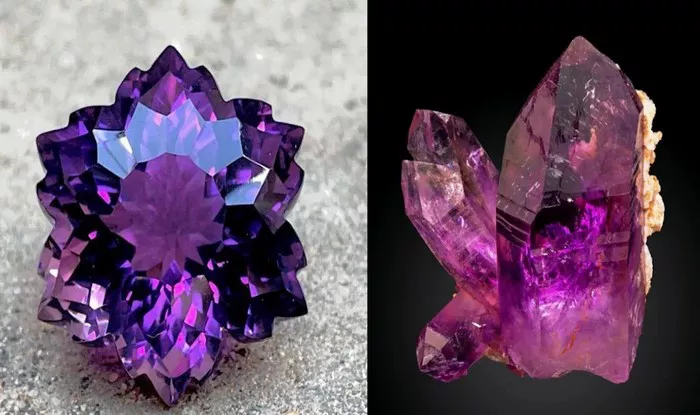Amethyst geodes, with their captivating beauty and purported metaphysical properties, have been cherished for centuries. These geological wonders, characterized by their rough exterior and sparkling, crystal-lined interior, are sought after by collectors and enthusiasts alike. However, in a market flooded with imitations and synthetics, determining the authenticity of an amethyst geode can be challenging. Fear not, for this comprehensive guide will equip you with the knowledge and tools necessary to discern the genuine from the counterfeit.
Understanding Amethyst Geodes
Before delving into the intricacies of authenticity assessment, it’s essential to grasp the fundamentals of amethyst geodes. These geological formations typically originate from volcanic rocks, where gas bubbles trapped within molten lava create cavities. Over millions of years, mineral-rich groundwater seeps into these voids, depositing crystals such as quartz, including the purple variety known as amethyst. The result is a stunning geode, prized for its natural beauty and spiritual significance.
Examining Physical Characteristics
One of the first steps in determining the authenticity of an amethyst geode is a careful examination of its physical characteristics. Authentic geodes exhibit certain features that distinguish them from their synthetic counterparts or natural substitutes.
1. Exterior Texture: Authentic amethyst geodes often possess a rough, irregular exterior surface, reflecting their geological origins. Look for subtle imperfections and irregularities in texture, as these are indicative of natural formation processes.
2. Weight and Density: Genuine amethyst geodes tend to be heavy for their size due to the density of the mineral crystals they contain. While weight alone is not a definitive indicator of authenticity, it can be a helpful factor when combined with other assessments.
3. Crystal Formation: Inspect the interior of the geode for the presence of crystal formations. Authentic amethyst geodes typically feature well-defined crystals with distinct terminations and varying shades of purple. Be wary of geodes with uniform, unnaturally colored crystals, as these may be indicative of artificial enhancement.
4. Color Consistency: Natural amethyst crystals exhibit variations in color intensity, ranging from pale lilac to deep violet. Beware of geodes with overly saturated or uniform coloration, as this may signal artificial treatment or dyeing.
5. Geological Inclusions: Authentic amethyst geodes may contain natural inclusions such as mineral deposits, air bubbles, or other geological features. These imperfections contribute to the geode’s authenticity and can serve as indicators of natural formation.
Conducting Basic Tests
In addition to visual inspection, several basic tests can help confirm the authenticity of an amethyst geode. These tests are non-destructive and can be performed with common household items.
1. Scratch Test: Authentic amethyst possesses a Mohs hardness of 7, making it relatively resistant to scratching. Use a sharp object such as a knife or nail to gently scratch the surface of the geode. If the surface exhibits scratches or damage, it may indicate that the geode is composed of a softer material or coated with a synthetic substance.
2. Ultraviolet Light Test: Some synthetic or treated amethyst may fluoresce under ultraviolet (UV) light. Expose the geode to a UV light source and observe any fluorescence emitted. While fluorescence alone does not necessarily indicate synthetic origin, it can be a useful supplemental test when combined with other assessments.
3. Heating Test: Authentic amethyst is generally resistant to heat and will not undergo significant changes when exposed to moderate temperatures. Use a hairdryer or heat gun to apply gentle heat to the surface of the geode. If the geode exhibits melting, discoloration, or emits a strong odor, it may indicate the presence of synthetic materials.
4. Water Test: Submerge the geode in a container of water and observe its behavior. Authentic amethyst is non-porous and should not absorb water or exhibit significant changes in buoyancy. If the geode absorbs water or becomes noticeably lighter, it may contain porous or artificial materials.
Seeking Expert Opinion
In cases where uncertainty persists or additional verification is desired, seeking the expertise of a qualified geologist or gemologist can provide invaluable insights. Professional appraisers possess specialized knowledge and analytical tools that enable them to assess the authenticity and quality of amethyst geodes with precision.
When consulting an expert, be sure to provide detailed information about the geode, including its physical characteristics, origin (if known), and any accompanying documentation or certificates of authenticity. Additionally, inquire about the appraiser’s experience and credentials to ensure their expertise aligns with your specific needs.
Conclusion
In a world inundated with replicas and synthetics, verifying the authenticity of an amethyst geode is essential for collectors and enthusiasts alike. By familiarizing yourself with the physical characteristics of authentic geodes, conducting basic tests, and seeking expert opinion when necessary, you can confidently differentiate genuine specimens from imitations.
Remember, the journey of exploration and discovery inherent in the pursuit of natural wonders such as amethyst geodes is as valuable as the treasures themselves. Armed with knowledge and curiosity, embark on your quest to unlock the mysteries of these mesmerizing geological marvels.

